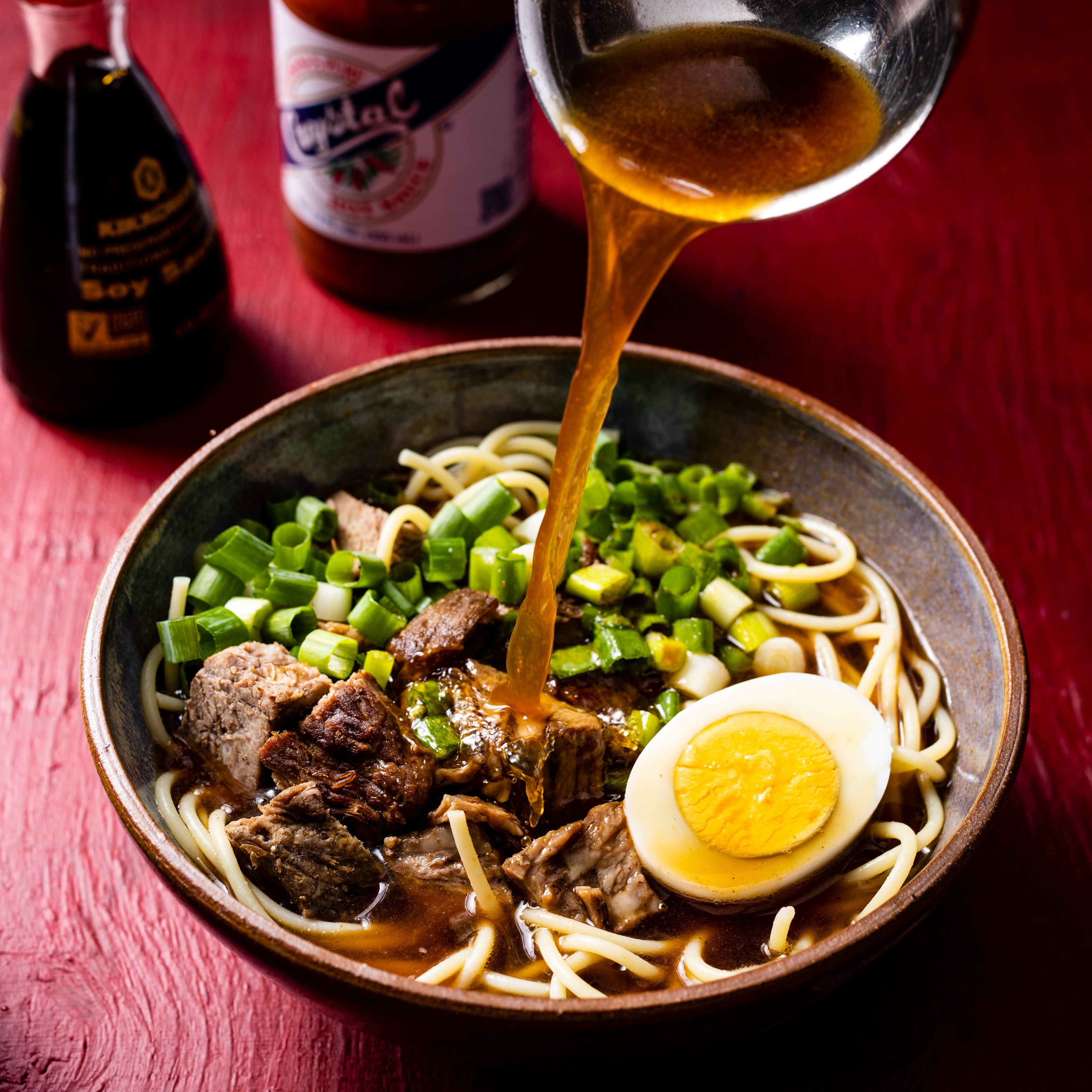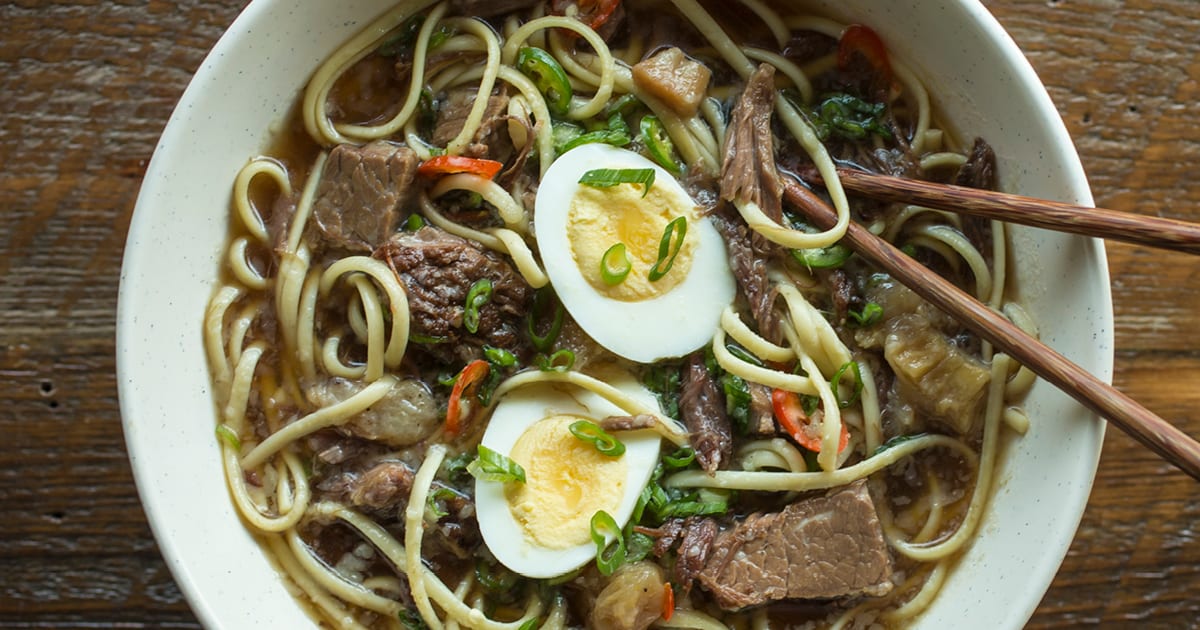Miss Linda’s Yakamein Recipe takes center stage, inviting you on a culinary journey where flavors dance and traditions intertwine. This beloved dish has captivated taste buds for generations, and now, we embark on a voyage to uncover its secrets and celebrate its enduring legacy.
From the carefully selected ingredients to the meticulous cooking techniques, every aspect of Miss Linda’s Yakamein Recipe holds significance. Join us as we explore the cultural tapestry woven into this culinary masterpiece.
Ingredients

Miss Linda’s yakamein recipe calls for a diverse array of ingredients, each contributing unique flavors and textures to the dish. These ingredients can be categorized into several groups:
Base Ingredients: These form the foundation of the yakamein and include:
- Noodles: Miss Linda uses thin, yellow egg noodles, which provide a chewy texture and absorb the flavorful broth.
- Broth: The broth is made from a combination of chicken and pork stock, providing a rich and savory base.
- Seasonings: Soy sauce, oyster sauce, and sesame oil add depth and umami to the broth.
Vegetables: Yakamein is known for its generous portion of vegetables, which provide color, texture, and nutrients:
- Bok choy: The dark leafy greens add a slightly bitter flavor and a crisp texture.
- Cabbage: Similar to bok choy, cabbage provides a crunchy texture and a mild flavor.
- Carrots: Thinly sliced carrots add a touch of sweetness and a vibrant color.
- Celery: Celery adds a subtle crunch and a hint of celery flavor.
- Green onions: The scallions provide a fresh, pungent flavor and a bright green color.
Protein: Miss Linda’s yakamein features a combination of protein sources:
- Pork: Ground pork adds a savory flavor and a hearty texture.
- Shrimp: Shrimp provides a delicate, slightly sweet flavor and a firm texture.
- Eggs: Eggs are beaten and added to the broth, creating tender egg ribbons.
Garnish: The finishing touches of Miss Linda’s yakamein include:
- Fried garlic: Crispy fried garlic adds a pungent, savory flavor.
- Sriracha: A drizzle of sriracha adds a spicy kick.
- Lime wedges: Lime wedges provide a refreshing citrus flavor and balance the richness of the dish.
Variations and Substitutions
While Miss Linda’s yakamein recipe is a classic, there are several variations and substitutions that can be made to suit individual preferences or dietary restrictions:
- Noodles: Rice noodles can be substituted for egg noodles for a gluten-free option.
- Broth: Vegetable broth can be used instead of chicken or pork broth for a vegetarian version.
- Protein: Tofu or seitan can be used as meat alternatives for a vegan or vegetarian yakamein.
- Vegetables: Other vegetables, such as mushrooms, bell peppers, or snap peas, can be added to the yakamein for extra flavor and nutrients.
Preparation: Miss Linda’s Yakamein Recipe
Preparing Miss Linda’s yakamein is a labor of love that requires patience and attention to detail. Follow these step-by-step instructions to create a flavorful and authentic yakamein that will delight your taste buds.
Chopping and Sautéing
Begin by finely chopping the onions, bell peppers, and green onions. In a large pot or Dutch oven, heat the oil over medium heat. Add the chopped vegetables and sauté until softened and translucent, about 5-7 minutes.
Adding the Meat and Seafood
Next, add the ground pork and shrimp to the pot. Season with salt and pepper and cook until the meat is browned and the shrimp is pink and opaque. Stir in the chopped garlic and ginger and cook for another minute until fragrant.
Simmering the Broth
Add the chicken broth, water, soy sauce, and fish sauce to the pot. Bring to a boil, then reduce heat to low and simmer for at least 30 minutes, or up to 2 hours for a richer flavor. Season to taste with additional salt and pepper if desired.
Adding the Noodles
Cook the noodles according to the package directions. Once the noodles are done, drain them and add them to the pot with the broth. Stir to combine.
Serving
Serve the yakamein hot, garnished with chopped green onions, fried shallots, and a squeeze of lime juice. Enjoy!
Cooking Techniques

Miss Linda’s yakamein recipe employs various cooking techniques that contribute to its distinctive flavor and texture. These techniques include sautéing, braising, and boiling, each playing a crucial role in the dish’s preparation.
Sautéing involves cooking ingredients in a small amount of fat over medium heat, stirring frequently. In the yakamein recipe, vegetables like onions and celery are sautéed to enhance their flavor and aroma, creating a flavorful base for the dish.
Braising
Braising is a cooking method that combines browning and simmering. Ingredients are first browned in a pot, then covered with liquid and cooked slowly over low heat. In the yakamein recipe, pork shoulder is braised in a flavorful broth, resulting in tender and juicy meat.
Boiling
Boiling involves cooking ingredients in boiling water. In the yakamein recipe, noodles are boiled until tender, providing a starchy base for the dish. The boiling process also extracts flavors from the ingredients, contributing to the overall taste of the yakamein.
These cooking techniques, when combined, create a harmonious balance of flavors and textures in Miss Linda’s yakamein recipe. Similar recipes that employ these techniques include gumbo, pho, and beef stew.
Cultural Significance
Miss Linda’s yakamein recipe holds immense cultural significance within its community, serving as a testament to the rich culinary heritage of the region. Originating as a humble dish prepared by Miss Linda herself, it has evolved into a beloved staple, cherished by locals and visitors alike.
Origins and Community Ties
Yakamein traces its roots to the early 19th century, brought to the area by Chinese immigrants. Over time, it has undergone local adaptations, incorporating flavors and ingredients unique to the region. Miss Linda’s recipe, in particular, is renowned for its distinct blend of spices and the use of fresh, locally sourced seafood.
The dish has become deeply ingrained in the community’s cultural identity, symbolizing hospitality and shared experiences. It is often served at family gatherings, community events, and celebrations, fostering a sense of belonging and connection among those who partake in it.
Anecdotes and Stories
Numerous stories and anecdotes attest to the cultural importance of Miss Linda’s yakamein. One notable tale involves a group of local fishermen who were caught in a storm and sought refuge in Miss Linda’s humble abode. Despite having little to offer, she generously shared her yakamein with them, providing warmth and sustenance during their time of need.
Another anecdote recounts the time when a visiting dignitary was so impressed by Miss Linda’s yakamein that they requested the recipe. She graciously obliged, and the dish quickly became a favorite at official functions, further solidifying its status as a symbol of local pride and hospitality.
Variations and Adaptations

Miss Linda’s yakamein recipe has inspired numerous variations and adaptations over the years, reflecting the diverse culinary traditions and preferences of different regions and communities.
These variations often stem from the availability of ingredients, regional cooking techniques, and personal preferences. Some common adaptations include:
Seafood Variations, Miss linda’s yakamein recipe
- Shrimp and crab yakamein: This variation incorporates fresh or frozen shrimp and crab meat into the broth, adding a rich seafood flavor.
- Fish yakamein: In coastal areas, fish such as catfish or snapper may be used as the primary protein, providing a lighter and more delicate taste.
Noodle Variations
- Udon yakamein: Thick, chewy udon noodles can be used instead of traditional egg noodles, creating a more substantial and satisfying dish.
- Ramen yakamein: Ramen noodles, known for their springy texture, can be substituted for egg noodles, adding a different flavor and texture to the soup.
Regional Adaptations
- Louisiana yakamein: This variation incorporates Cajun spices and seasonings, such as cayenne pepper and paprika, giving the dish a spicy and flavorful twist.
- Mississippi yakamein: In the Mississippi Delta region, yakamein is often served with fried catfish or shrimp, adding a crispy and savory element to the soup.
These variations and adaptations showcase the versatility and adaptability of Miss Linda’s yakamein recipe, allowing it to be customized and enjoyed by people from all walks of life.
Presentation and Serving
Miss Linda’s yakamein is traditionally served in a large bowl or plate. The noodles are placed in the center, topped with the seafood, vegetables, and broth. The dish is often garnished with green onions, cilantro, and a squeeze of lime juice. These garnishes add a fresh and flavorful contrast to the rich and savory yakamein.
Significance of Garnishes
The garnishes play a crucial role in enhancing the overall taste and presentation of the yakamein. Green onions provide a sharp and pungent flavor, while cilantro adds a bright and herbaceous aroma. Lime juice brings a refreshing acidity that balances the richness of the broth. These garnishes not only add visual appeal but also complement the flavors of the dish.
Modern Presentation
In recent years, chefs have begun to experiment with modern and innovative ways to present yakamein. Some popular variations include:
- Serving the yakamein in individual bowls or ramekins.
- Arranging the noodles and toppings in a more visually appealing manner, such as creating a “nest” of noodles.
- Using edible flowers or herbs as garnishes to add a touch of elegance.
- Incorporating molecular gastronomy techniques, such as spherification or foam, to create unique textures and flavors.
Wrap-Up
As we bid farewell to Miss Linda’s Yakamein Recipe, we carry with us a profound appreciation for its culinary artistry and cultural significance. May this recipe continue to inspire and delight generations to come, serving as a testament to the enduring power of tradition and the boundless joy of sharing a delicious meal.
Popular Questions
What is the secret to Miss Linda’s Yakamein’s rich flavor?
The secret lies in the harmonious blend of fresh seafood, savory pork, and a medley of aromatic spices.
Can I substitute any ingredients in the recipe?
While substitutions are possible, it is recommended to stay true to the original ingredients to preserve the authentic flavors of Miss Linda’s Yakamein.
What is the best way to serve Miss Linda’s Yakamein?
Traditionally, Miss Linda’s Yakamein is served hot with a sprinkle of chopped green onions and a side of crusty bread for dipping.